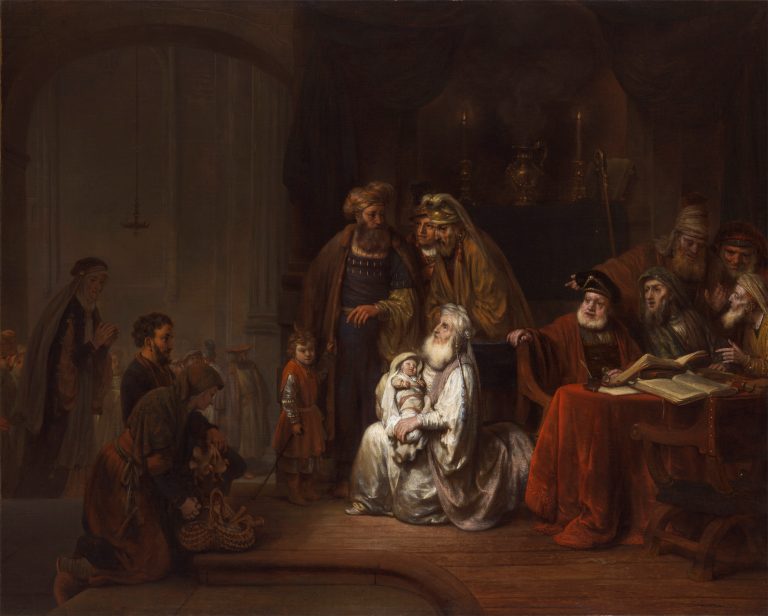The Gospel of Luke (2:22–39) tells the story of Mary and Joseph who, according to Jewish law, brought their first-born son to Jerusalem “to present him to the Lord” (Luke 2:22). In the temple they met Simeon, a devout old man to whom the Holy Ghost had disclosed “that he should not see death, before he had seen the Lord’s Christ” (Luke 2:26). Simeon recognized the infant as the Savior, took him in his arms, and thanked God with the following words: “Lord, now lettest thou thy servant depart in peace, according to thy word: For mine eyes have seen thy salvation” (Luke 2:29–30). After giving praise to God, Simeon blessed Mary and revealed to her the first dark prophecy about the fate of her son.
Gerbrand van den Eeckhout’s composition shows the bearded Simeon kneeling in the temple next to a chair on a raised wooden platform with the infant Jesus in his arms. Gazing heavenward, he utters his song of praise (“Nunc dimittis”). Behind him stand three men in oriental attire, one of them in the company of a boy dressed in red, who holds a staff in his right hand. At the far right, a group of five scribes are gathered around a table covered with a number of open books. The two scribes on the left turn toward Simeon, while the other three discuss the event among themselves. Kneeling at the edge of the raised wooden platform across from Simeon are Mary and Joseph, with Joseph holding two sacrificial doves in his left hand. Behind them approaches the prophetess Anna, her hands folded in prayer. The Bible relates that she “was a widow of about fourscore and four years, which departed not from the temple, but served God with fastings and prayers night and day. And she coming in that instant gave thanks likewise unto the Lord” (Luke 2:37–38).
Van den Eeckhout portrayed this theme a number of times in the 1660s and early 1670s. In addition to this work, other examples of his representations of the Presentation in the Temple are found in Dresden and Budapest.1 Yet another version was in the museum in Berlin until the Second World War, but this work has since disappeared.2 The present painting, dated 1672, is the latest of the artist’s known versions of the theme.
The Leiden Collection painting is recorded in three Amsterdam auction catalogues of the late eighteenth century: 1776, 1777, and 1797.3 All three praise the quality of the picture and commend it as one of the painter’s principal works, noting that its chiaroscuro, draughtsmanship, palette, costumes, and emotional expression all surpass Van den Eeckhout’s other work. The sale catalogues of 1776 and 1777, however, wrongly assert that Arnold Houbraken mentioned this painting in his Groote Schouburgh (1718–21). Although Houbraken does discuss a painting by Van den Eeckhout “depicting Jesus in the arms of Simeon,” it was a different work. The painting Houbraken described was in the possession of Jakob Hinlopen, as is evident in the poem by Jan Vos that he quotes in its entirety.4 Vos’s poem, however, first appeared in the 1662 edition of his poetry, that is, ten years before Van den Eeckhout executed the Leiden Collection painting.5
A striking detail in Simeon in the Temple is the boy dressed in red holding the hand of the man behind Simeon, but his identity is not known. No child of this age is mentioned in the biblical text nor is such a child featured in prior pictorial traditions. In the auction catalogue of 1776, the two figures are incorrectly identified as Zacharias and his son John (the Baptist). Zacharias was the high priest of the temple of Jerusalem (see Luke 1:5) and, as a priest, he would not be wearing a turban. Moreover, his son John was only six months older than Christ (see Luke 1:26) and therefore he cannot be this boy.
When painting the Dresden version of this subject (fig 1), which dates from the mid-1660s, Van den Eeckhout looked carefully at Rembrandt van Rijn’s (1606–69) etching The Presentation in the Temple of ca. 1639 (fig 2). Several motifs in the Leiden Collection painting also recall that etching, among them the disposition of the figures, with the main scene taking place in the right fore- and middle ground. As in Rembrandt’s etching, a view opens up at the left into the depths of the temple. Other similarities include the group formed by the kneeling Simeon and the Christ child, and the prophetess Anna, approaching from the left.
This painting is one of the principal pieces of Van den Eeckhout’s last working years, particularly notable for the way he has dramatized the scene by allowing light to fall on Simeon and the Christ child. He gave further prominence to these figures through the white robe that Simeon wears and the radiant white swaddling clothes of Christ. These two figures almost seem to glow, a visual reference to Simeon’s characterization of the Child as “a light to lighten the Gentiles” (Luke 2:32). Moreover, in contrast to other pictures made in Van den Eeckhout’s later years, in which he experimented—not always convincingly—with compositions featuring a few nearly life-size figures,7 the painting in the Leiden Collection depicts a scene rich in figures, in which the painter’s narrative qualities come to the fore. Worthy of comparison are The Denarius of Caesar of 1673 in Lille and The Calling of Matthew of 1674 in Munich.8 In these small-figure works, Van den Eeckhout displays his talent as a compelling storyteller and subtle colorist, which made him one of the most successful and most versatile painters in Rembrandt’s immediate circle.
